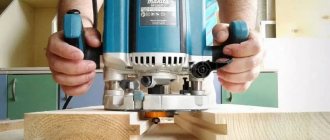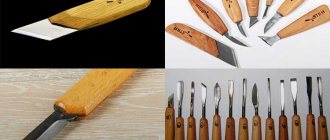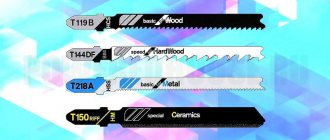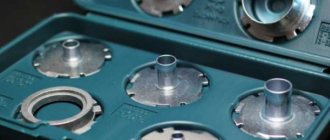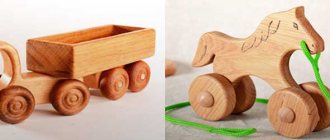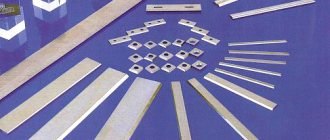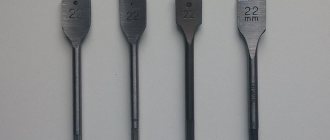Grinding attachment for jigsaw
Almost every self-respecting craftsman has an electric jigsaw. This is simply an indispensable tool for cutting plywood and boards, sawing out various workpieces.
However, the functionality of a jigsaw is not limited to cutting. In this article from a construction magazine, we will try to adapt a jigsaw for grinding. Of course, a sanding attachment on an electric jigsaw cannot replace a full-fledged sander, but it will definitely come in handy for various woodworking projects.
Basic rules for cutting plywood or chipboard
The most suitable tools are circular or band saws.
There are many cutting tools, and not just one, but several will be used at once.
To get a clean cut, you need to follow the rules:
- saws with fine teeth are suitable for work;
- First of all, the material is sawn across the grain, then along. This method will prevent corners from splitting;
- on the front side the material is sawed with a hand or band saw;
- from the wrong side - saw with a contour or disk tool;
- when working with a circular saw, it is necessary to ensure high speed and low material feed ratio;
- the teeth of the circular saw should penetrate shallowly into the surface;
- in order for fewer creases to appear on the board, you need to guide the saw along the cutting line, with light pressure and slight kickback;
- adhesive tape attached along the cutting line will protect the material from chipping.
In practice, two professional interchangeable tools are used - a jigsaw and a jigsaw.
In a home workshop you can achieve an even cut. But it is better to entrust work with dimensional sheet materials to professionals with specialized equipment.
Main operating principles
The set of tools we need will consist of:
- Machine oil.
- Protective gloves.
- Points.
- Jigsaw.
- Processed material.
The fastening for the material being cut must be strong, at the maximum level.
With a crooked cut, there is a possibility of disturbances in the stability of the table. It is also necessary to check the strength of the position of the workpiece itself.
It is recommended not to cut wood along the grain if using a jigsaw. In this case, making an even cut becomes almost impossible.
It is better to give preference to a parallel fence if the need for such work still arises. One side of the stop is connected to the jigsaw. One of the edges of the wood product should be a stop for the other side. Then you can get an even cut.
How to cut a tabletop without chips using a hacksaw
A regular hacksaw will work to cut the tabletop. However, when working, you need to take into account that you need to leave a margin of at least 100 mm. The tool must have fine teeth. It would be better if it was a hacksaw for metal.
You can saw off the tabletop with a hacksaw.
Attention! The teeth must be hardened and set apart by ½ the thickness of the material.
To work, you will need paper adhesive tape, a file for rough cuts and sandpaper for finishing.
Take several measurements to ensure an even cut.
How to properly cut a tabletop with a hacksaw:
- Mark a cutting line with a sharp tool;
- stick paper adhesive tape along the markings to protect the top decorative layer;
- direct the movements of the hacksaw at an acute angle to the surface of the sheet (no more than 30 degrees);
- cut smoothly, with medium pressure.
All irregularities can be hidden with sandpaper.
If chips appear, they need to be processed with a file, moving from the edges to the center. Sand any remaining minor defects with fine-grained sandpaper.
Tool characteristics
Jigsaws are divided into household and professional.
Using household tools with a power of 350-620 W, they perform a small amount of work on wood up to 70-80 mm thick, sheet steel up to 4 mm thick. A professional power tool is designed for a large volume of work, provides continuous operation for 8 hours, and productivity does not decrease. Household models have a smaller set of additional functions. Important operating functions are stroke frequency, power, method of fastening the saw blade, pendulum movement, equipped with a saw blade rotation device, regulation of the number of strokes to optimize work with different materials. Single-speed jigsaws without speed adjustment are used for sawing wood.
A jigsaw is often used when carrying out finishing work, for curvilinear cutting, creating internal holes, shaped parts in the manufacture of furniture, while the material being worked with needs to be fixed. To secure the material, you can use clamps; the cuts are first marked on the material, then the tool is turned on and sawing begins.
The principle of operation is to convert the rotational movement of the shaft into the translational movement of the working mechanism - the file. The file is mounted on a rod - a round plate, the quality of which determines the durability of the part. When choosing a power tool, you should pay attention to the round shape and thickened rods.
Scheme of cutting a circle with a jigsaw.
Can I cut with a jigsaw?
The tool is suitable for making small cuts. You will need a tool for working with metal, with fine teeth. The cut is made along the front side: this way there will be fewer chips on it, and there will be small irregularities on the back side.
When working with a jigsaw, the cut is made from the reverse side due to the direction of the teeth on the file.
When working, the tool is not set to maximum speed, but slightly above average. The tool must be moved with smooth movements, with light pressure.
Important! The method is not suitable for cutting long materials, since it is difficult to maintain an even cut line.
Dull saws need to be replaced.
Guide rail for jigsaw
The guide for a jigsaw is a simple device, at first glance, similar to a large metal ruler or rule. The main difference between the tire and the above devices is a special groove along which, like on rails, the sole with a jigsaw mounted on it moves. Most guides have rubberized strips that prevent sliding on the surface of the material, and for additional fixation, they are attached with small clamps. The average length of such devices is from 1.5 to 3 meters, and can be increased by another, similar ruler, using an adapter.
To make the line as neat and even as possible, use the optimal file suitable for the material being processed. More visual processes for making and using a homemade guide are demonstrated in the following videos.
Source: instrumentoria.ru
How to cut with a circular saw
The tool can make long cuts, but during operation more chips are formed (compared to cutting with a jigsaw). You will need a saw blade with fine teeth.
You should work with electrical appliances carefully.
As a rule, the side where the teeth cut remains clean, but chips appear on the opposite side.
You should start cutting from the front edge (facade) to avoid chipping on this part.
It is more convenient to work with a saw fixed on the table. This way you are not busy with the tool and you can use the guide. This will increase the cutting accuracy and allow you to make several parts.
Use tools correctly.
Chips that form after cutting can be processed with a file and sandpaper.
What's next
Start with the first clamp. It is clamped after checking the strength of the installation.
Then they turn on the jigsaw. And they do it so that the speed is maximum. The pendulum control is set to the first digit.
The file must be placed close to the cutting line. The guide is compressed with the platform side. After this, they begin cutting.
The tool moves forward smoothly and the platform is carefully controlled. The platform and guide must move closer to each other so that nothing moves. The sawn-off part must be carefully held with a few centimeters remaining to the end. Then the part will not break off.
Sawing with a router
A great way to get a clean cut. First, the material is cut with a jigsaw at a distance of 2-3 mm from the marking line. Then a cutter is used to align the line according to a pre-prepared template. A cutter with a bearing is suitable for the job.
When cutting simple chipboard, no complications can arise, but with laminated chipboard everything is much more complicated.
This method can be used to make not only straight, but also curved cuts, and to produce radius parts.
We select a saw blade with the largest number of teeth to ensure an even cut.
Among the disadvantages of the method: it is necessary to apply precise markings, file the workpieces in advance and place the template under the router. That is, it is inconvenient for the tool to cut off several identical parts.
Design and its features
Each jigsaw has a so-called support sole. It always rests on the part that needs to be sawed. Due to this, the accuracy of work is noticeably increased.
The soleplate can be easily rotated to make bevel cuts. Some manufacturers produce models in which the main tool is fixed only at a certain angle.
The file acts as the main cutting tool. Tooth spacing, sharpening method, size, shape, materials - literally every model has its own. 75, 85 and 100 millimeters are the most suitable lengths if you need to cut materials of low density. The saw step size also becomes a fairly important parameter.
- Metal requires a pitch of 12 millimeters.
- For wooden products it is from 2.5 to 4.
Sawing with a format saw
The most suitable tool that can be used to cut boards and pressed materials of different thicknesses. The cuts are precise and multiple parts can be stamped.
Professional machines are used for industrial purposes.
They are small in size and weight (up to 20 kg), and easy to install. If necessary, the machine can be removed and moved to another location. The tool is suitable for longitudinal cutting to a depth of up to 8 cm. Also, in a home workshop, you can saw the tabletop with a circular saw with an extended work table.
At home, household machines are usually used.
They are more convenient than household ones, as they allow you to make cuts not only along longitudinal, but also along transverse lines. The maximum cutting depth is 9 cm. When working, you need to apply precise markings and follow safety precautions.
Step-by-step schemes for beginners
To understand the basics of wood carving, it is worth mastering the lessons step by step - from the simplest to the more complex. For beginners, and especially for children, you should immediately talk about safety precautions in order to prevent possible injuries.
any objects with your own hands, it is important to know what is needed for this and what the sequence of actions should be.
The simplest technique is to learn contour carving, for which you need to prepare the basic equipment:
In order to cut wood , it is important to tell everything about chisels and show them in action. Handmade work is distinguished by its subtlety, so don’t rush and start cutting without a sketch. Drawings are prepared on paper, carefully thought out, and then transferred to wood .
The basics of working with chisels and a jamb knife are carried out on workpieces with straight and wavy lines.
A beginning carver must get a feel for the tool and learn how to work with it. As soon as it starts to work out consistently, you can choose a sketch and try to bring it to life. The most common themes for carving are animals and natural landscapes with various objects. After the work is completed, the workpiece is sanded and painted.
The name "square drill" comes from the shape of the hole the bit is capable of drilling. Externally, such drills have the shape of a triangle (tip), but with their help it is possible to obtain square-shaped openings. The nozzles in question are classified according to a number of the following characteristics:
What difficulties may arise when choosing a drill for a square hole? It would seem that no difficulties would arise at all. You just need to come to the store and tell the seller the size and shape of the opening that you want to get in the end. When purchasing a slotting cutter, you will need to pay attention to the following technical parameters:
- Manufacturer - the devices in question are manufactured by all modern companies, not only domestic, but also foreign. The prices of such drills differ depending on who the manufacturer is. The high cost of a product does not always indicate its quality, so you need to choose depending on how often you plan to use the nozzle. If often, then it is better to give preference to products from the manufacturer Rapid. Chinese nozzles are cheaper, so they are not designed for long-term use
- The length of the drill depends on how deep the opening needs to be in the end. The most common options for cutters in length from 160 to 225 mm
- The size of the square hole - it all depends on the task at hand. Depending on the size of the mandrel, the nozzles have corresponding parameters. You need to understand that this is one of the main parameters. The nozzle bit always has a smaller diameter than the mandrel size
- Shank type - it is important to pay attention to this parameter, since it will not be possible to secure a drill with a tapered shank in a drill chuck
- Purpose - depending on what material is planned to be processed - steel or wood. For steel workpieces, products made of high-alloy and high-speed steel are used, and for wood, nozzles made of carbon steel are produced
| Drill size | d, mm | B, mm | L, mm | C, mm | D, mm | E, mm |
| 6x6 | 4 | 45 | 160 | 115 | 6 | 19 |
| 8x8 | 5,7 | 50 | 205 | 135 | 8 | 19 |
| 10x10 | 6,8 | 50 | 205 | 140 | 10 | 19 |
| 12x12 | 9,5 | 70 | 210 | 140 | 12 | 19 |
| Drill size | d, mm | B, mm | L, mm | C, mm | D, mm | E, mm |
| 6x6 | 4 | 45 | 160 | 115 | 6 | 19 |
| 8x8 | 5,7 | 50 | 205 | 135 | 8 | 19 |
| 10x10 | 6,8 | 50 | 205 | 140 | 10 | 19 |
| 12x12 | 9,5 | 70 | 210 | 140 | 12 | 19 |
Expert opinion
Strebizh Viktor Fedorovich, leading construction foreman
The bar can interfere with cutting circles of small diameter if it does not allow you to move the needle as close to the jigsaw as possible, which will prevent you from cutting a circle of the minimum radius. If you want to clarify something, please contact me!
Trimming sawing method
This method also involves using a circular saw, but a plunge-cut saw is more suitable. You will need a double ruler: it is fixed to the workpiece with clamps. The principle of operation is the same as that of a format-cutting machine: two cuts are made along the same line.
This is what the ruler-bus is used for. It is installed along the marking line, the laminate is lightly cut without disturbing its texture. Then the material is sawed along the marked trace.
By the way! Thanks to the cut on the laminate, no chips will form during the second deep cut.
The cut area can be sealed with an edge.
Using this method, you can cut the tabletop into one or more parts. Minimal chips are possible, but they can be easily removed by regular sanding or hidden with a decorative overlay.
Round cuts can also be masked.
Disadvantage: This method can only make straight cuts.
Correct sawing technique
Cutting and fitting plywood
The most difficult question is choosing files with the appropriate size for this tool.
There is a very wide range of these products on the market.
And many of them are only a few millimeters thick.
The main thing is to remember that these files are only enough for a couple of hours of work.
And they must be handled very carefully.
The smallest saws can only process plywood.
If the material is harder and dense, it means you need to take a larger file. This will also help answer the question of how to cut plywood smoothly.
What cannot be sawed
A grinder or an angle grinder is something you should not use to saw a tabletop. Some masters recommend this method to save time. However, it has more disadvantages than advantages.
Use a level to make precise cuts.
Firstly, the quality of the parts is low: due to the sudden movement of the disk, many chips appear. Secondly, if large discs are used, there is a high risk of injury.
Professionals will make better cuts thanks to the availability of special devices.
In addition, after work a lot of dust remains, which is unacceptable at home.
DIY file
If you have your own workshop, a file can be made from available materials. It won't be difficult. For example, it can be made from a tin can, thick steel wire or guitar string. An ordinary tin can will help you save your budget; the average cost of such a canvas is 35 rubles per piece. A file made of steel wire will perform its function just as well, and will last longer than many cheap fakes. What you need during production and the process itself can be easily found on the Internet.
Final stage
In the last step you need to use another tool. You will need a spray or file, sandpaper, GOI board, adhesive tape and a decorative duralumin corner.
First of all, you need to polish the wood. To do this, you can use a spray or a file to remove the excess. Then use a sander or regular sandpaper (no sanding) to keep the wood looking good. It is recommended that you do this work even if you don't intend to do anything else afterwards. Due to the torn elements of the wood, the material will attract moisture much faster, which will cause faster wear of the material.
READ How to Saw a Chipboard Countertop
Having restored the tree to normal, it is necessary to bring the plastic to the same condition. Usually it is enough to use special polishes. But if this is not available, you should not buy a new one, because you will need very little of this tool to finish one tabletop, and then throw away the AL-KO varnish, which is not economical.
The ideal option for plastic recycling is GOI paste. It is available in almost every home, and is a completely versatile tool and quite effective.
Even if the cut was successful and of high quality grinding, it is better to play on it safely so that even small millimeters do not make themselves felt in the future. Therefore, for finishing it is recommended to use a special furniture corner made of duralumin. It needs to be secured in place until the appearance is neat.
Templates
Shot glasses, cups, plates, pots or baking dishes - in any household there are many round-shaped objects that can be used to mark a circle. If you are making something and decide to give your product a rounded shape, then first look to see if there is a suitable template among the household utensils.
To be sure, select a few items and take them to the workshop. There you can immediately try them on the workpiece and determine what is most suitable. With some practice, you will be able to make rounded lines from several round objects with different radii. Arcs of a circle can be drawn sequentially, or bridges-transitions can be made between individual arcs.
Before attempting to trace a curve on a piece of paper, design it on a large piece of paper or piece of corrugated cardboard. Only after the result is satisfactory in all respects can you cut out a template from paper and make markings on it on the workpiece.
You can draw circles and fragments of a circle using a cup or plate by simply tracing them with a pencil.
The sink is one of the most important elements of kitchen equipment. If you decide to cut your sink into your kitchen worktop yourself, the first thing you need to do is prepare an exact template.
First, transfer the outer outline of the shell onto a thick sheet of paper. Next, measure the width of its sides, which will rest on the tabletop. Usually this is 2-3 cm. Now step back from the outline drawn on the paper, inward by the width of the side and draw a parallel line. This will be the cutting line.
When applying markings, make sure that the position of the template itself on the plate is correct. Of course, if all the corners of the sink are symmetrical, then nothing bad will happen if, according to the markings, it appears to be in a mirror image. But if the sink has the shape of a trapezoid and the roundings at the front corners differ from the roundings at the back, then under no circumstances confuse the front and back parts.
Use a similar pattern to make templates and cut holes for wall lights or loudspeakers mounted on wood panels.
The line drawn around the sink is auxiliary. The second, drawn parallel closer to the center, is the sawing line.
Tabletop connector - euro saw: hidden docking (photo)
A method of processing ends that uses patterns. To create it you need a milling machine. Only with high-quality equipment it turns out flawless.
Sometimes euro-sawing is produced on a cutting machine - this significantly reduces the cost of production, however, with such economical production, the ends are obtained with fluctuations of a millimeter or more. Therefore, when purchasing, you should check this point very carefully, especially if the price of a prefabricated kitchen surface is significantly reduced. A poorly made joint will not connect as it should, leaving gaps.
Correctly executed ends after assembly form a surface on which the gap is not visible at all - it is there, but its width is a fraction of a millimeter. If the coating is dark in color, it will not be easy to find where the euro-cut table top was cut (photo).
Such ideal quality can only be obtained using a router, and the patterns must be new or at least not worn out.
Key rules
To make the sawing process simple and fast, you must follow the basic key operating rules:
To ensure that the edges of the plywood are even, it is better to cut along the blade.
- You can only work with dry material, since humidity increases the resistance of the material, as a result of which the veneer may begin to delaminate;
- it is necessary to change the cutting blade immediately after the first signs of dullness of the teeth appear;
- It is better to work with a jigsaw along the fibers of the material, so the edges will be smoother;
- Use a hand jigsaw to cut across the grain of the veneer.
To ensure safe work, you must adhere to the following recommendations:
- securely fasten the sawing table and the file in the frame;
- the jigsaw must have serviceable and well-fitted handles;
- You should not press the jigsaw too hard, trying to “help” it, this will only lead to an acceleration of dulling of the working blade;
- It is best to make straight and long cuts with a wide blade, so the cutting process will go faster;
- You must always see the markings, so sawdust must be removed from the material being cut by hand, and under no circumstances should you blow it away, as it can get into your eyes.
Following these simple rules will help a beginner learn how to cut circles with a jigsaw and make his work easier.
What do we cut from?
If the goal of our work is to create an object with high aesthetic characteristics (and this is the case in most cases), then we need to start with the choice of material.
Plywood for sawing with a jigsaw must meet a number of requirements:
- Firstly, you should select the optimal sheet thickness. If we cut out a shaped piece of furniture from plywood with our own hands, then we can use panels 12-15 mm thick, and even thicker ones. If our goal is finer work, then accordingly we need to purchase material of 5 mm or even less.
Different thicknesses for different tasks
- The color of the veneer from which the plywood is made plays a role only if we do not plan to finish the finished product with stain, varnish or paint. But most often they don’t pay attention to the color - it won’t be visible anyway!
- The moisture content of the material is a critical parameter specifically for cutting with a jigsaw. The plywood sheets must be thoroughly dried, otherwise our main task will be replacing saw blades.
As for quality, only first or second grade plywood is suitable for artistic cutting:
- There should be no knots or stains on the sheet.
- There should be no “pockets” of resin inside the slab.
- You should choose only those panels whose veneer is glued with sufficient quality.
Veneer delamination
Advice! To determine the quality of veneer sizing, it is enough to saw off a strip 10-20 mm wide from the edge of the sheet with a regular saw. If such a thin fragment does not delaminate, the sheet can be put to work.
